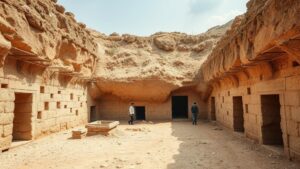Exploring the basalt formations of the Faroe Islands for evidence of early Viking settlements.
Exploring the Basalt Formations of the Faroe Islands for Evidence of Early Viking Settlements
The Faroe Islands, an archipelago situated between the Norwegian Sea and the North Atlantic Ocean, comprise 18 volcanic islands known for their dramatic basalt cliffs and stunning natural landscapes. These islands have not only captured the attention of geologists but also historians, particularly due to their connection to the Viking Age. The exploration of the basalt formations in this region presents valuable insights into early Viking settlements, their lives, and their interactions with the surrounding environment.
A Brief Overview of the Faroe Islands
Discovered by Norsemen led by Floki Vilgerðarson in the 9th century, the Faroe Islands are characterized by their rugged terrain, shaped by volcanic activity and glaciation. islands reach heights of over 800 meters, with basalt columns rising dramatically from the sea, creating striking geological features. Not only are these formations aesthetically pleasing, but they also carry historical significance, providing clues to the past inhabitants of the region.
The Role of Basalt in Viking Settlements
Basalt, an igneous rock formed from cooled lava, is prevalent in the Faroe Islands. This stone played a critical role in the construction and defensive structures of the early Viking settlements. durability and abundance of basalt made it an ideal building material for longhouses, farmsteads, and fortifications.
Significant Archaeological Sites
Several key archaeological sites across the Faroe Islands have provided substantial evidence of early Viking habitation:
- Ási Farm: Located on the island of Suðuroy, this site features well-preserved remnants of a Viking farm, including stone walls made from basalt. Artefacts such as pottery and tools found here date back to around 870 AD.
- Sandavágur: The discovery of Viking graves and remnants of longhouses suggests this site was a thriving settlement where Norse farmers cultivated the land as early as the 9th century.
- Tórshavn: The capital city of the Faroe Islands has yielded significant findings, including remnants of a Viking harbor, believed to have served as a crucial point for trade and exploration.
Historical Context of Viking Settlements
The Viking Age in the Faroe Islands is estimated to have begun around 850 AD, coinciding with the expansion of Norse culture across Northern Europe. The establishment of farms and trading posts transformed the islands into a key player in maritime routes. strategic location also afforded the Vikings easy access to the British Isles and other significant trade networks.
Artifact analysis indicates that the Vikings who settled in the Faroe Islands were not only warriors but also skilled farmers and seafarers. Their adaptation to the challenging climate is evident in the tools and technologies they used, many of which were made from locally sourced basalt.
Evidence of Daily Life and Culture
While the basalt formations are primarily linked to the physical structures, they also contribute to understanding the cultural aspect of Viking life. Artifacts such as:
- Fishing tools and implements made from stone and bone suggest a reliance on maritime resources.
- Evidences of cattle and sheep herding highlight their agricultural practices.
- Pottery fragments reveal that trade routes extended beyond the islands, connecting them with other Norse and Celtic cultures.
These findings provide a glimpse into the daily lives of the Vikings, illustrating a community that relied heavily on their environment while demonstrating adaptability and resilience.
Contemporary Exploration and Preservation Efforts
Today, archaeological efforts continue to unearth new evidence of Viking settlements in the Faroe Islands, with both local and international researchers collaborating to enhance our understanding of this period. Preservation initiatives are vital to protect these significant sites from natural erosion and human activities that could threaten their integrity.
Visitor engagement also plays a crucial role in these efforts. Guided tours that highlight the historical significance of the basalt formations and early settlements are becoming increasingly popular, providing a dual benefit of promoting awareness while generating support for preservation.
Conclusion
The basalt formations of the Faroe Islands serve as more than just remarkable geological features; they are a testament to the rich history of the Viking settlements that once thrived in this rugged landscape. As research continues to shed light on this fascinating period, it becomes clear that understanding the past is essential for preserving the integrity of these sites for future generations.
For those interested in history, archaeology, or simply the beauty of nature, exploring the Faroe Islands offers a multifaceted experience that combines the best of both worlds. legacies left behind by the Vikings remind us of the resilience of human culture against the backdrop of an often formidable environment.


